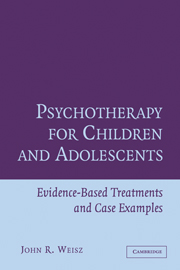Book contents
- Frontmatter
- Contents
- Preface
- SECTION A GENERAL INTRODUCTION
- SECTION B TREATMENTS FOR FEARS AND ANXIETY
- SECTION C TREATMENTS FOR DEPRESSION
- SECTION D TREATMENTS FOR ATTENTION DEFICIT/HYPERACTIVITY DISORDER
- SECTION E TREATMENTS FOR CONDUCT PROBLEMS AND CONDUCT DISORDER
- SECTION F CONCLUSION
- 14 Evidence-Based Youth Psychotherapies: Strengths, Limitations, and Future Directions
- References
- Author Index
- Subject Index
14 - Evidence-Based Youth Psychotherapies: Strengths, Limitations, and Future Directions
Published online by Cambridge University Press: 06 July 2010
- Frontmatter
- Contents
- Preface
- SECTION A GENERAL INTRODUCTION
- SECTION B TREATMENTS FOR FEARS AND ANXIETY
- SECTION C TREATMENTS FOR DEPRESSION
- SECTION D TREATMENTS FOR ATTENTION DEFICIT/HYPERACTIVITY DISORDER
- SECTION E TREATMENTS FOR CONDUCT PROBLEMS AND CONDUCT DISORDER
- SECTION F CONCLUSION
- 14 Evidence-Based Youth Psychotherapies: Strengths, Limitations, and Future Directions
- References
- Author Index
- Subject Index
Summary
In this book, we have examined a variety of evidence-based psychotherapies for children and adolescents. The therapies encompass the four broad clusters of problems and disorders that account for most referrals for outpatient child and adolescent mental health care: anxiety, depression, ADHD, and conduct problems and conduct disorder. The descriptions and critiques in each of the chapters have revealed several strengths and several limitations in each of the specific treatments and in the evidence base bearing on each of them. In this final chapter, I adopt a broader focus, describe some important strengths and gaps in the literature more generally, and highlight some issues that need special attention in future treatment development and in future treatment research. I also propose a specific model for treatment development and testing, one that I believe could contribute significantly toward bridging the gulf that still exists between clinical research and clinical practice.
Strengths of the Evidence on Youth Psychotherapy Effects
The broad evidence base on youth treatment, surveyed in Chapter 1, and the specific treatments and the research on them, discussed in subsequent chapters, shows substantial strengths – strengths that represent good news for all of us who care about youth mental health care.
Overall Magnitude and Durability of Treatment Effects. First, the meta-analytic findings we reviewed in Chapter 1 showed that the average effect of youth treatments tested in peer-reviewed studies is quite respectable, falling between commonly used benchmarks for medium and large effects (Cohen, 1988). Treatment effects have also proven to be durable, with little drop-off in benefit over the five to six months that is common in posttreatment follow-up assessments.
- Type
- Chapter
- Information
- Psychotherapy for Children and AdolescentsEvidence-Based Treatments and Case Examples, pp. 447 - 472Publisher: Cambridge University PressPrint publication year: 2004

